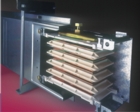Extolling the benefits of aluminium busbar trunking systems

The performance of aluminium busbar trunking systems has so improved over the last few years that they have many advantages over copper — as John Clarke explains
Over the last 50 years, busbar power distribution systems have increased in versatility and sophistication and are now widely regarded as the first-choice solution for power distribution projects in most industrial and commercial applications.
It’s not difficult to see why. Compared to conventional hard-wired forms of power distribution, the latest generation of busbar systems with aluminium conductors have several key benefits.
They are lighter than traditional busbars and easier to install. As a result, they take less time to install, which offers considerable cost savings. They are manufactured using high-quality components and have built-in safety features. They also offer flexibility in design and can be easily adapted and modified as future requirements change.
With all this in mind, perhaps the question is no longer whether busbar systems are better than conventional hard-wired systems, but rather which busbar trunking to use — aluminium or copper?
Aluminium has long been regarded as the poor relation to copper as an electrical conductor, and consultants have been reluctant to specify systems with aluminium conductors — often basing their decision on outdated information or misinformation.
Over the past few years, however, significant advances have been made, and the aluminium used in busbar trunking systems today is an exceptionally high performance product which offers cost-savings, excellent mechanical strength, heat stability and thermal conductivity characteristics which compare very favourably with those of copper.
Cost is also an important issue. On the world’s commodity markets, aluminium tends to have a more stable price and, unlike copper, is not so sensitive to the ebb and flow of consumer demand, political uncertainties and other economic factors. As a result, aluminium has consistently provided huge cost savings for specifiers and contractors. This is obviously a major consideration for all concerned in the highly competitive market of power distribution projects.
The biggest advantage that aluminium has over copper is therefore quite simply — cost.
Aluminium is up to 70% lighter than copper, which not only saves money on transportation, but also on the time, effort (and therefore cost) of installation.

Although copper is a better conductor of electricity than aluminium (aluminium’s conductivity is 62% that of copper), copper is three times heavier than aluminium, which as previously stated has a significant impact on the cost of installation and transportation. When you compare an aluminium system against a copper-based system of equal size and weight, aluminium scores twice as conductive as copper.
In the past, specifiers have been critical of the fact that aluminium is susceptible to oxidisation, which affects contact conductivity at the joint. Manufacturers of busbar systems have overcome this problem by completely electro-tin plating the conductor bars, which automatically eliminates any problems associated with jointing dissimilar metals.
Unlike ferrous metals, aluminium does not generate sparks when used in combination with other metals, making it the ideal choice for use in potentially inflammable or explosive environments. Zucchini uses zinc and tin-plated aluminium in its busbar construction, which makes the aluminium longer lasting and easy to work/maintain.
As aluminium is non-magnetic, it is ideal for use in applications that need minimum magnetic interference. These include high-voltage applications as well as electronics.
Aluminium is also a strong material, with aluminium alloys having a mechanical resistance of 60 to 530 N/mm².
In summary, I hope that readers involved with power distribution projects give further consideration to the advantages of specifying aluminium busbar systems — particularly in terms of performance, safety and cost. More information is provided in several publications from Zucchini.
John Clarke is general manager of Zucchini Busbar.







